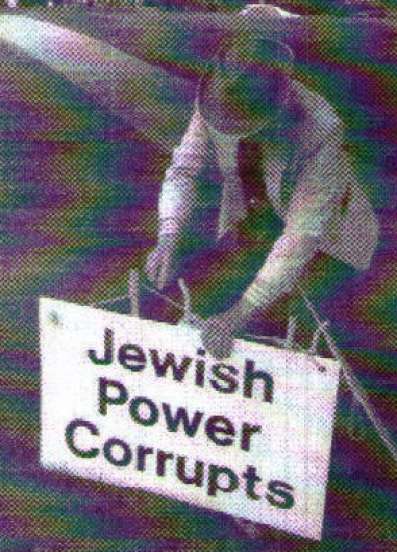
From today’s decision (which I think is quite correct) in Gerber v. Herskovitz, an opinion by Judge Jeffrey Sutton joined by Judge David McKeague:
Every Saturday morning since September 2003, [Anti-Israel] protesters have picketed the Beth Israel Synagogue [in Ann Arbor]. Their group typically comprises six to twelve people, and they display signs on the grassy sections by the sidewalk in front of the synagogue and across the street from it. The signs carry inflammatory messages, with statements such as “Resist Jewish Power,” “Jewish Power Corrupts,” “Stop Funding Israel,” “End the Palestinian Holocaust,” and “No More Holocaust Movies.” The protests apparently target the members of the Beth Israel Congregation, as they coincide with the arrival of the congregants to their worship service on Saturday morning. The congregants and their children can see the signs as they enter their worship service. But the protesters have never prevented them from entering their house of worship, have never trespassed on synagogue property, and have never disrupted their services….
The court concluded that the plaintiffs had standing to sue over the emotional distress that this speech caused them (the district court had concluded the contrary); but on the merits, the court held against the plaintiffs:
The protesters’ actions come squarely within First Amendment protections of public discourse in public fora. As in Snyder v. Phelps, the content and form of the protests demonstrate that they concern public matters: American-Israeli relations. As in Snyder, the protest location is a quintessential public forum: public sidewalks. The context of being outside a house of worship at the time of a service cuts slightly towards being a private attack, but that factor alone was not heavy enough to tip the balance in Snyder, and it is likewise too feathery here.
The congregants claim that the First Amendment does not apply to the unique features of this protest. Five considerations, they say, make this case novel: (1) the protests’ proximity to a house of worship, (2) their location in a residential area, (3) the fact that the congregants are a captive audience, (4) the frequency of the protests, and (5) the exposure of congregants’ children to the signs. But each of these factors is old hat under the First Amendment.
Take the first three. Courts have allowed speech restrictions based on concerns for a captive audience in a deliberately narrow context, and we see no justification for expanding it here. Snyder insisted on the concept’s narrowness, applying it only to an individual’s residence and declining to extend it to a church holding a funeral. Our sister circuits have likewise declined to allow restrictions on protesting near houses of worship, rejecting justifications like those the congregants offer. Expressive activity in a residential area by itself does not suffice for an exception; an individual’s home itself must be the focus of the protest. Frisby v. Schultz.
The congregants’ fourth and fifth factors fall readily as well. The protesters’ actions do not lose constitutional protection just because they have been protesting for a long period of time. Free-speech protections do not expire over time or come with a rule against perpetuities. And the Supreme Court has repeatedly held that an interest in protecting children does not justify censoring speech addressed to adults. Reno v. ACLU.
The congregants’ proposed remedy—an injunction prohibiting protests within 1000 feet of the synagogue during Saturday morning services and limiting the number of protesters and signs—likely would violate the First Amendment anyway. State action “would not be content neutral,” the Supreme Court has explained, “if it were concerned with undesirable effects that arise from the direct impact of speech on its audience or [l]isteners’ reactions to speech.” Understandable though the congregants’ reaction to the protesters’ speech may be, that by itself—without physical impediments to their services or trespassing—cannot suffice as the kind of “content-neutral justification” needed to make the proposed injunction a reasonable time, place, and manner restriction. The restriction, moreover, would disproportionately affect one viewpoint on an issue of public concern, which makes us pause before concluding it would be “justified without reference to the content of the regulated speech.”
Even if the request were eligible for treatment as a time, place, and manner restriction, the injunction would be overly broad. Neither the 1000-foot buffer zone nor the restriction to five protesters at any time is likely to satisfy narrow tailoring. Madsen v. Women’s Health Center held that a 300-foot buffer zone was not narrowly tailored, and our circuit has held that like-sized zones are overbroad.
Judge Eric Clay would have held that plaintiffs lack standing, though he also agreed that “Plaintiffs’ arguments that Protester Defendants’ demonstrations are not protected by the First Amendment are completely unfounded”:
Plaintiffs’ allegations of extreme emotional distress fail to establish standing in this case because there is no legally protected interest in not being offended by the speech of others…. It is not “an invasion of a legally protected interest” to be presented with offensive or disagreeable speech on matters of public concern….
He also spoke to plaintiffs’ claim that the defendants speech was unprotected under Beauharnais v. Illinois (1952), which upheld a “group libel” statute:
[I]n Beauharnais, the Supreme Court, over a vigorous dissent, upheld the defendant’s conviction under an Illinois statute that prohibited publication of group libel, defined as portraying a lack of virtue of a class of citizens. While the decision has never explicitly been overruled, it appears that the case has been limited to its precise facts in subsequent decisions of the Supreme Court. N.Y. Times v. Sullivan; see Nuxoll ex rel. Nuxoll v. Indian Prairie Sch. Dist. #204 (7th Cir. 2008) (“Anyway, though Beauharnais v. Illinois, 343 U.S. 250 (1952), has never been overruled, no one thinks the First Amendment would today be interpreted to allow group defamation to be prohibited.”).
from Latest – Reason.com https://ift.tt/39cmKHg
via IFTTT